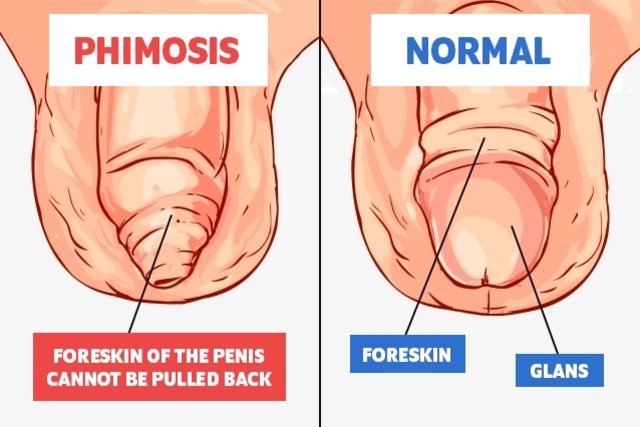Phimosis is the inability to expose the glans, which is the terminal part of the penis, because of an excess of the covering foreskin.
This condition is common in infants and tends to disappear, in most cases before 1 year of age. Sometimes it takes longer to resolve naturally and may disappear closer to 5 years of age or only at puberty, without the need for specific treatment. However, as time passes and the foreskin continues not to allow the glans to be exposed, it may be necessary to use a specific ointment or have surgery.
There are 2 types of male phimosis:
- Physiological phimosis: it is the most common condition and is present from birth;
- Secondary phimosis: may occur at any stage of life, after repeated infection or local trauma, for example.
In some cases, the foreskin is so tight, that even urine can get trapped inside the skin, increasing the risk of a urinary tract infection. Phimosis can cause various complications such as difficulty cleaning the region, increased risk of urinary tract infection, pain during intimate contact, increased risk of having an STD, HPV or penile cancer, and a greater possibility of developing paraphimosis, which is when the foreskin gets stuck and can no longer get back to its flaccid position covering the glans.

How is phimosis diagnosed
The only way to confirm the presence of phimosis is to try to retract the skin that covers the penile glans manually. When it is not possible to see the glans completely, this indicates phimosis, which can be classified in 5 different degrees. Although the degree is important, the best treatment is determined according to the boy's age. The first check for the presence of phimosis is done on the newborn baby, but it is part of all pediatric appointments until the age of 5.
When secondary phimosis appears in adolescence or adult life, men usually can observe themselves the difficulty in retracting the foreskin. If they see they have this problem we recommend they consult a urologist.
During the appointment, the doctor tries to retract the skin that covers the glans and if this is not possible the diagnosis of phimosis is reached.
Treatment options for phimosis
Phimosis detected in children is curable and doesn't always need specific treatment, and so it is important that the pediatrician evaluates the situation to determine the course of action because sometimes it resolves itself naturally around the age of 4 or 5. If phimosis persists after this age or secondary phimosis occurs, specific treatment is necessary, which can be done with:
1. Phimosis ointments
You should apply corticosteroid-based ointments that have anti-inflammatory, analgesic and antibiotic properties, making it easier for the skin to glide over the glans. The ointment prescribed by the doctor is normally applied twice a day for 1 month and may be enough to cure phimosis.
2. Phimosis retraction exercises
In boys over the age of 5 there are some exercises that can be done to try and reduce phimosis; however, they must be done without forcing or causing any pain.
To do the exercise you should hold the penis with one hand and with the other apply the ointment and pull the skin back slowly, for 1 minute, 3 to 4 times a day. This exercise should not cause pain or discomfort but should "loosen the skin little by little". If the exercise is not done correctly, besides the pain, it may form scars, new adhesions, and a fibrosis ring, which is a characteristic of paraphimosis.
3. Phimosis surgery
When the treatment mentioned above is insufficient, a patient can undergo surgery to treat phimosis which is called a postectomy, after 2 years of age. The surgical procedure should be carried out by the doctor, taking into account the age and degree of phimosis and consists of completely removing excess skin or making small cuts in the skin of the region to facilitate exposure of the glans.
Phimosis surgery isn't possible until any existing problems are resolved, such as problems with blood clotting, local infection, or in cases of penile abnormalities, because in these cases there is a greater risk of complications and it may be necessary to take advantage of the skin removed to reconstruct some tissue in the genital region.
Can phimosis occur in women
Although rare, it is possible for women to have phimosis, which is characterized by the adherence of the small lips of the vagina, covering the vaginal opening. However, this adherence does not cover the clitoris or urethra, which is the channel through which urine passes.
As in boys, female phimosis can be resolved over time as a girl develops. However, if the adherence is persistent, specific treatment may be required that should be recommended by a pediatrician or gynecologist.
